Updated by "Forest Circular Economy" Editorial Board on June 13, 2025, 11:25 AM JST
Editorial Board, Forest Circular Economy
Forestcircularity-editor
We aim to realize "Vision 2050: Japan Shines, Forest Circular Economy" promoted by the Platinum Forest Industry Initiative. We will disseminate ideas and initiatives to promote biomass chemistry, realize woody and lumbery communities, and encourage innovation in the forestry industry in order to fully utilize forest resources to decarbonize the economy, strengthen economic security, and create local communities.
The sound of high-performance forestry equipment engines echoing through a satoyama forest, where a single operator handles everything from felling to pruning and slashing, demonstrating that smart forestry is becoming a reality. What is about to begin in western Toyama Prefecture is a "stockyard project" that will fully utilize the region's forest resources and deliver them to downstream industries. This concept is at the core of the Platinum Forest Industry Initiative's "Vision 2050: Japan Shines with a Forest Circular Economy," and is seen as the key to rebuilding the forestry industry into a "profitable industry. The editorial department of "Forest Circular Economy" reports from the site on the challenges being taken on by the Western Toyama Forest Utilization Project Study Council.
One of the key players in the council is Nanto City-based Shimada Lumber. At a forestry operation site in Oyabe City, where the company is contracted by the Western Toyama Prefecture Forestry Cooperative, the latest high-performance forestry equipment is in operation, and the company continues to take on the challenge of improving work efficiency and safety.
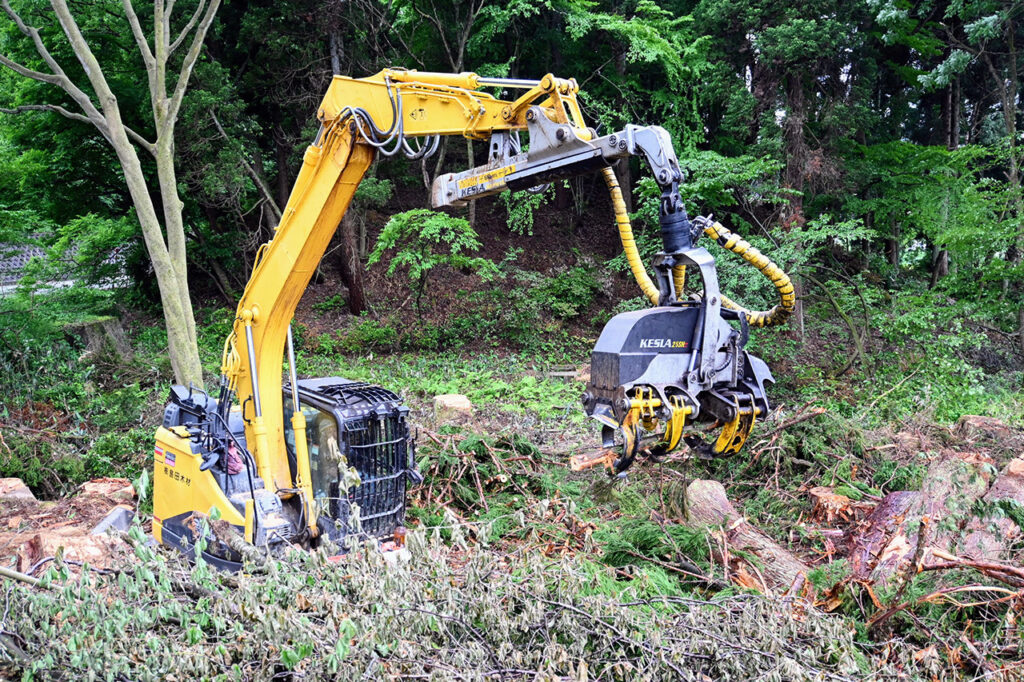
In May 2025, at a forestry operation site in a satoyama near a rural area, a huge harvester roared into action, cutting down cedar trees one after another, clearing branches, and cutting balls. Under the skillful control of the operator, the trees were quickly shaped into logs, grabbed by the grapple, loaded onto the forwarder, and accumulated on a nearby dirt field. The harvester is much faster than chainsaw operations and improves worker safety.
On an approximately 2 ha work area, work is being carried out by two loggers and one hauler. The increase in the number of types of machinery has expanded the range of work per person, resulting in labor savings. The company is actively promoting smart forestry by utilizing GPS to clarify and survey boundaries and GIS software for efficient forest management.
In the past, the forestry industry was faced with a declining number of bearers, an aging workforce, and low productivity. However, the wave of efficiency and labor savings brought about by high-performance forestry machinery is steadily coming to this area. Why do forestry sites need to change now? It is because this is an urgent issue for maximizing the potential of planted forests, which have entered the period of full-scale main cutting, and for making forestry a sustainable industry.
Our company is now mainly engaged in main cutting," says Yuhei Shimada, president of the company. Main logging is a method of forest management in which mature trees are cut down all at once for the purpose of forest renewal. In the past, thinning was mainly used to thin out trees that were still growing, but this method was not profitable and large machinery could not easily enter dense forests. Main logging is essential for improving efficiency and realizing "profitable forestry" because it can produce a large volume of timber at a time and is highly effective in introducing high-performance machinery.
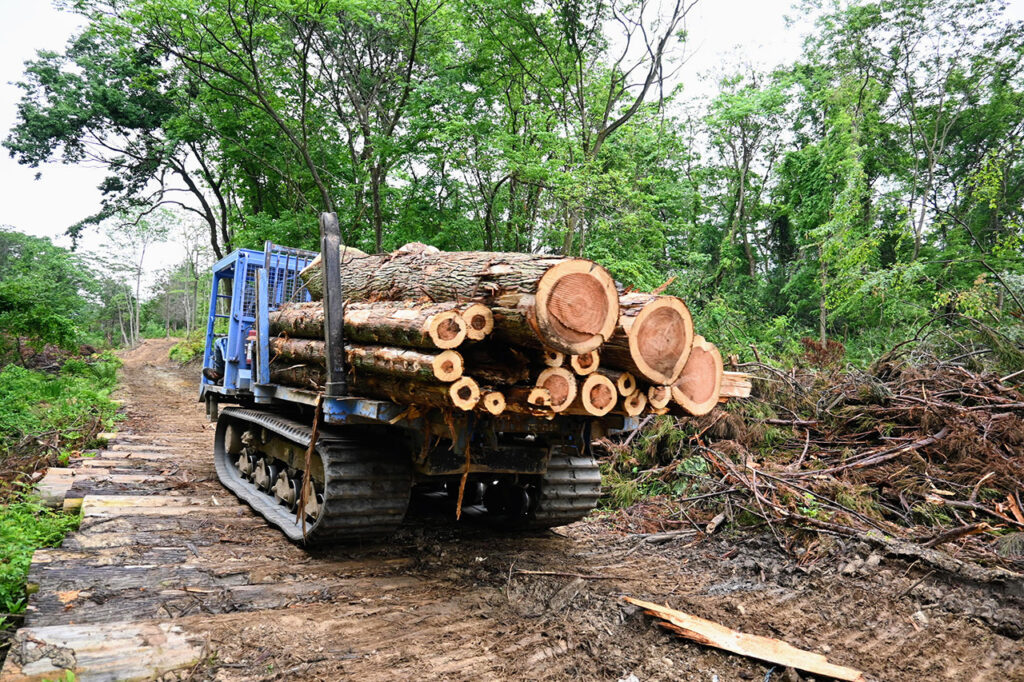
However, a look at the site reveals that transportation has become a cost bottleneck. Forwarders and other machinery are used to transport (collect) lumber cut in the mountains to a log storage area, but the roads are narrow and inadequately maintained.
Efficiently collecting timber from a wide area with large trailers is also difficult due to Japan's road conditions and legal regulations. Even if logging can be done efficiently in the mountains, if it cannot be transported out, it will not be a viable business. This issue of transportation cost and efficiency is one of the reasons why the stockyard concept was designed to reduce CO2 emissions during transportation by limiting the area of timber collection to a radius of 30 km or less.
Shimada Lumber's dojo is stocked with logs of various sizes. A wide variety of logs are brought in from the mountains and forests, ranging from high quality logs used for construction purposes to crooked and thin logs that are not up to standard.
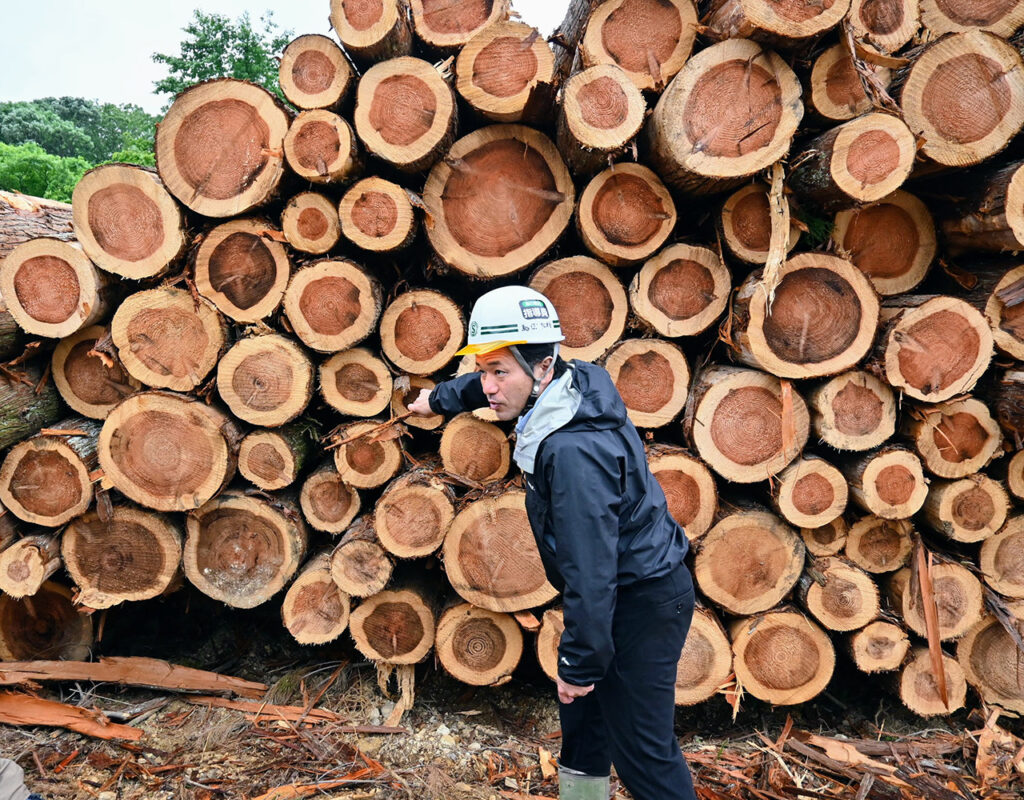
President Shimada also points out the problem of overgrown logs. He says, "Logs that are too thick are expensive to cut down and tend to have fewer uses. The stockyard business, which aims to "purchase the entire volume," including such off-spec lumber and thick logs, is an answer to the problems faced by individual forestry operators in terms of sales channels and tree selection costs.
I think it is also important to consider how to make use of the currently unutilized resource of branches and leaves that are left on the mountain. Currently, branches and leaves are not utilized due to high transportation costs, but if there is a system in which they can be made effective by being converted into chips at stockyards, etc., and there is a slight increase in the cost of transportation, it would make the business even more attractive and make it easier for forestry companies to become involved," noted President Shimada.
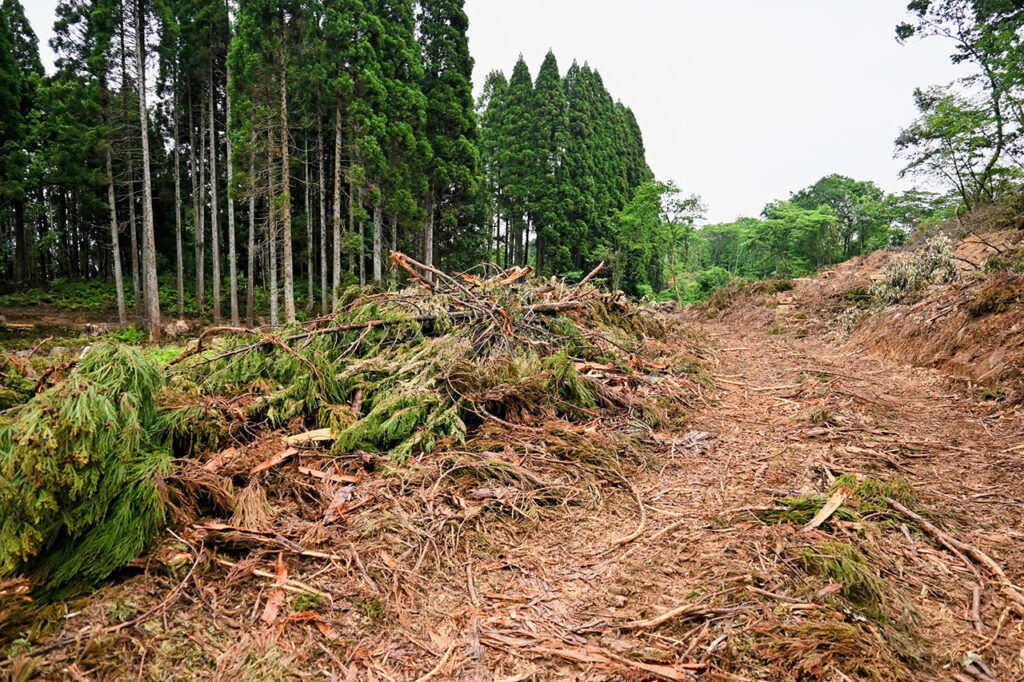
The stockyards will assume "full purchase" of the entire amount of wood, including such low-quality wood. The goal is to secure new uses for the wood, such as local production for local consumption and woody biomass heat supply, and to purchase the wood at a reasonable price.
The lush green man-made forests on site are now in full-scale main cutting season for cedar and cypress trees that were intensively planted in the postwar period. However, the cyclical cycle of forest resources, in which these trees are cut down and planted back up again, has long been stagnant in Japan. The low profitability of the forestry industry and the small-scale, non-intensive forest ownership structure have made sustainable management difficult.
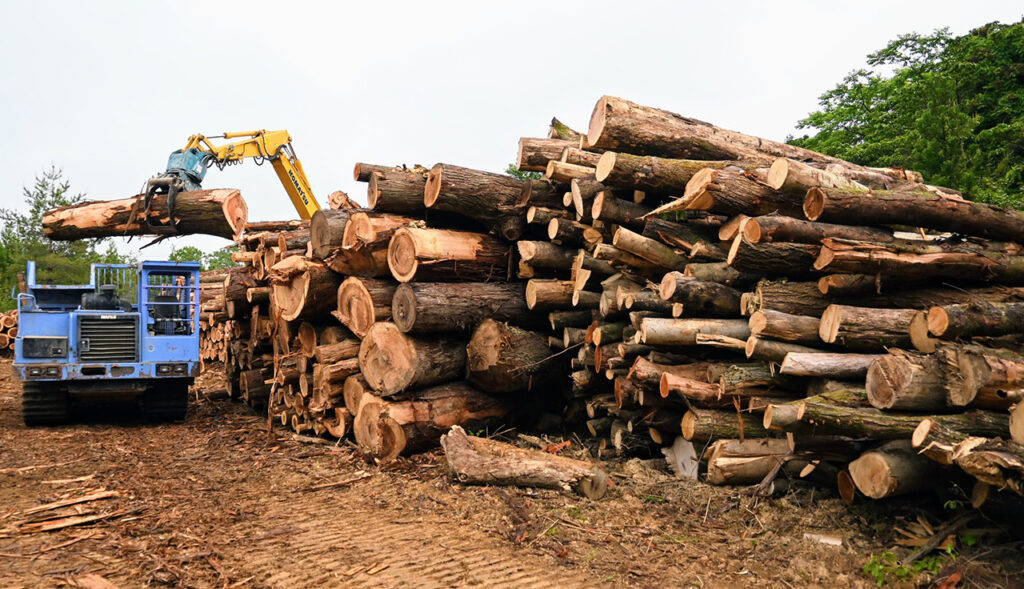
There are also structural issues that are difficult to resolve through onsite efforts alone. The work environment is hazardous, and the number of forest owners is aging and decreasing. The small-scale forest ownership structure has hindered intensification and increased production costs. In addition, management risks such as fluctuating timber prices and uncertain sales channels, as well as the problem of "unutilized timber"-inferior quality timber that is left in the mountains without buyers-are major obstacles to the effective use of resources and profitability for forestry companies.
Without overcoming these challenges and transforming forestry into a sustainable and attractive industry, it will be difficult to achieve goals such as decarbonization and revitalization of local economies. This is why the innovative business model of "stockyards" is needed.
If the entire amount of the purchase price is realized and an income commensurate with the cost of logging is secured, there will be an incentive to reforest the forests. This is truly an attempt to put all the trees in the mountains into the economic cycle as resources, and has the potential to fundamentally change the management mindset of forestry companies," says President Shimada with high expectations.
Kishida Lumber, based in Himi City, is another important player in the lumber industry in western Toyama Prefecture. A lumber manufacturer with a history of about 140 years, its corporate philosophy is to utilize 100% of trees grown over 50 to 100 years. As a cascade use of lumber, the company processes A lumber for residential construction and BC lumber for civil engineering, pallets, and other industrial materials. As a medium-sized sawmill that produces 20,000 cubic meters of lumber annually, the company is taking on the challenge of increasing efficiency and saving labor by investing in equipment.
Inside the factory, twin band saws for large-diameter lumber were roaring. The two band saws cut the logs at the same time, efficiently cutting out square timbers and other materials. 3- and 4-meter square timbers can be sawed in about 30 seconds per log.
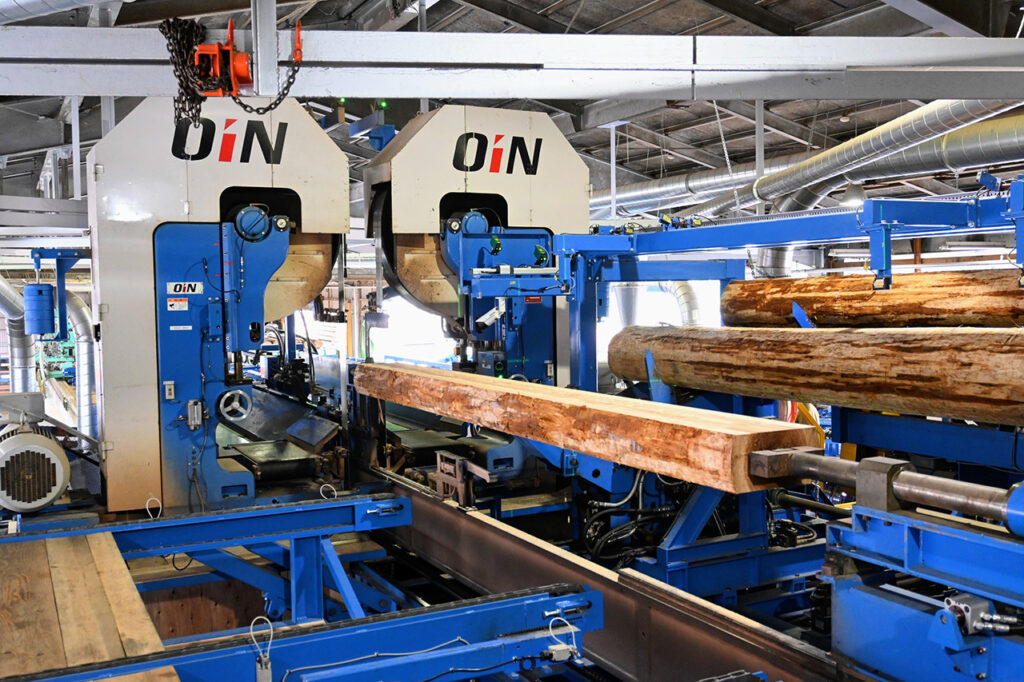
At Kishida Lumber's intermediate soil yard, logs brought in from neighboring prefectures are collected and sorted. According to the person in charge, only about 50% of the logs sorted here become building materials. The remaining half is processed into chips for use in paper manufacturing and fuel.
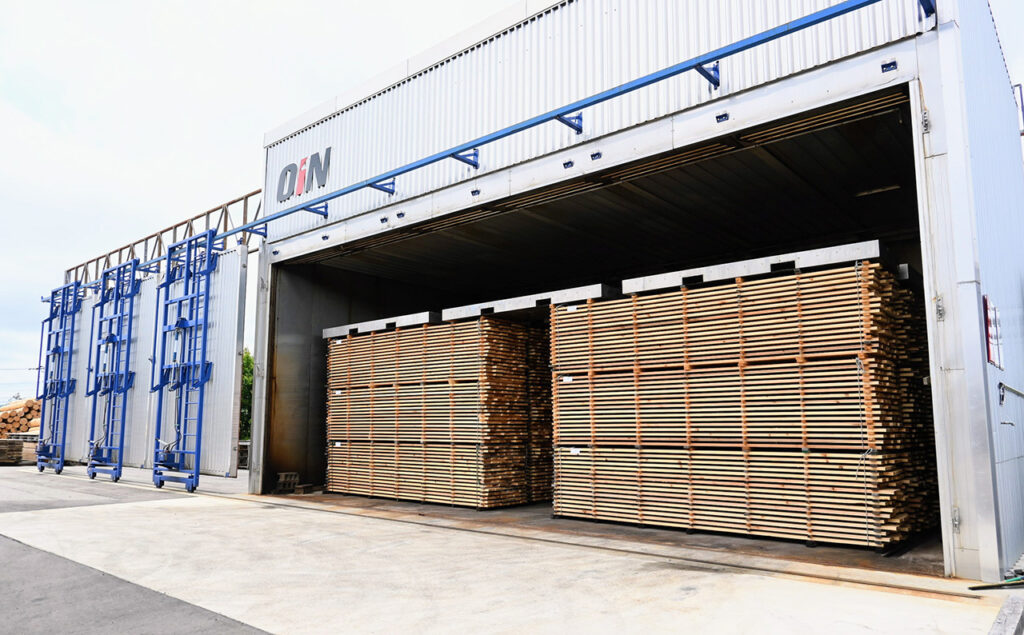
Without a certain scale and efficiency, it is difficult for sawmills to remain cost competitive. The 100,000 cubic meter per year scale proposed for the stockyard project is the result of taking into consideration the economic rationale for the processing stage.
If the quality and supply of logs are unstable, planned production will be difficult. If appropriate selection and quality control are carried out in the stockyards, and if a stable supply of high-quality lumber suitable for sawmilling and processing into high-value-added products is increased, it will lead to improved product competitiveness and profitability," said Takeshi Kishida, chairman of the company, who also has high expectations for the company.
The Platinum Forest Industry Initiative's "Vision 2050The "Forestry" project aims to simultaneously achieve decarbonization, enhanced economic security, and regional development by moving away from dependence on fossil resources and making full use of domestic forest resources. One of the pillars of the promotion strategy to realize this goal is the realization of a "profitable forestry industry.

The "stockyard project" is proposed as a specific business model for realizing a "profitable forestry industry. The core of this concept is the development of accumulation centers throughout Japan that guarantee the "total purchase" of all timber produced from forests and forestry. The aim is not merely to collect timber, but to collect a large volume of logs, approximately 100,000 cubic meters per year, and to establish a planned cycle of main cutting and reforestation in the surrounding forests with this as the nucleus.
Based on the philosophy of cascade utilization, the stockyard project will purchase all trees regardless of quality or standard, and function to allocate them to the most appropriate use (construction, civil engineering, pallets and other industrial materials, local biomass, etc.). By adding a sawmill, a chip factory, and even a biomass chemical plant on an adjacent site, the project aims to maximize the value of timber by improving the efficiency of collection, processing, and distribution. This will free forestry operators from market risks, provide them with a stable income, and enable them to systematically manage and reinvest in their forests.